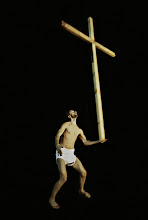Dinner with America
by Rajni Shah
Laban Theatre, 6-7 April 2009.
“How do problems in space resolve themselves in the symbolic order?” asks Nato Thompson in the April-May issue of Bookforum. He continues: “How do skirmishes in the symbolic order resolve themselves in space?”
Thompson is part of a round table on “Experimental Geography,” but his questions are highly appropriate to Rajni Shah’s Dinner with America. Shah’s performance attempts to approach the physical, conceptual and historical geographies we might want to identify as “America,” then seeks to map, explore and tweak them through a single body; taut, minimal but imagistic scenography; the duration of a performance time close to three hours.
It’s a difficult tension to embody: America’s physical configurations paling alongside its symbolic spread, the paradox of its vast military spending and its still pervasive connotations of freedom. Here translating that into performance requires a delicacy. Audience members enter in small groups, going through the Laban theatre into the hangar-like backstage space behind. A text projected on the floor makes clear the rules: we are welcome to move around the space, enter and leave as we wish. Our clothing is tagged as we enter by having a stars and stripe wrapped boiled sweet stapled to it.
Shah is covered in white gowns and headdress, and over the duration slowly sheds her bridal clothes to reveal, piece by piece, face and body. Blonde haired to start, with plastic looking skin as if a fifth-cyborg, she is ageless and aged mix of the Statue of Liberty, Buffy and a teenage cheerleader, who, for maybe two hours, makes repeated attempts to sing Amazing Grace. The voice is tentative, then strong, quavering then trying vibrato. Different postures, too. An arm is raised, opening a door into some iconographic turbulence. Black Power salute? Statue of Liberty? Madonna in concert?
It’s a duration that asks itself and us: can a voice, a body, a limited array of gestures articulate and carry a symbolic history? Certainly, and also certainly not. As Shah sings and sings, two handmaidens in white orchestrate the space around her. Their actions are specific and purposeful, illusive and ultimately pointless. Sweeping piles of wood chips, arranging neon strip lights in different configurations on the floor. Sometimes the ensuing shapes seem to have acquired meaning and the audience - sitting, standing, laying down throughout the space - stand en masse and moves forwards to look.
At one such group moment strip lights form a rectangular, wood-chip filled configuration around the singing Shah. I’m expecting the stars and stripes, or perhaps some physical representation of the North American continent. It is a haunting shape, but eludes easy connotation. Even as we all try and figure out what it is, the restless handmaidens are dismantling, constructing something new, caught between building and erasing. Visually striking as it is, this mythical America is not about iconic spectacle, but about how myth is tested and enacted with continual actions, bodies, voices, and songs.
Then Shah slowly sheds her eyelashes, wig, clothes and mask, to stand naked on the stage, much shorter now, brown-skinned, shaved head. It’s a Wizard of Oz moment, an awareness of the disjunction between a myth and its components, bursting out of the form itself. In the afterglow of the previous two hours, there is no sense of the naked body as outside of the constructed myth. Perhaps it is the “real body” that is mythical here.
Finally, handmaidens make the neon lights into a screen for projection, burying it beneath wood chips. Words are projected telling us “THE FEAST IS COMING.” Small envelopes are handed out - mine contains a card asking me to discuss a situation when I had been deprived of my freedom. Trays of fruit and chocolate are placed before us. Shah and the handmaidens are smiling now, encouraging the audience to eat and talk.
We were, it seemed, supposed to discuss the cards, but I didn’t. Perhaps the show’s success is an awkward embarrassment at this moment, highlighting the gap between emotional immersion and intellectual critique. Or maybe I was just being unsociable. Still, the dates were delicious, and it made me wonder what these different stages of the evening represented.
Partly, as we stood around and chatted, it was about having moved through a ritualistic encounter with a myth, returning to our own situation. It was a statement that an alternative mythology is possible, based on chocolate, fruit, conversation and a greater degree of informality, participation, and indirection. It was about going deeper into the myth itself to reveal its pleasures. All America and all part of its - and this performances - feast.
David Berridge writes and edits the blogzine More Milk Yvette: A Journal of the Broken Screen at www.moremilkyvette.blogspot.com
moremilkyvette@gmail.com

.jpg)
No comments:
Post a Comment